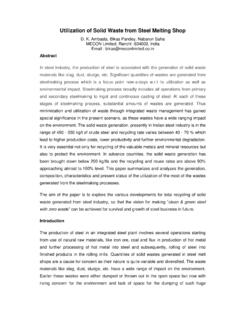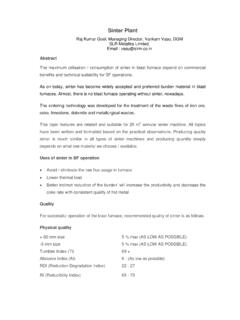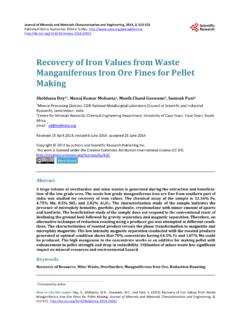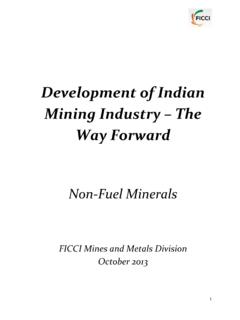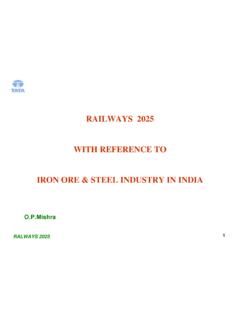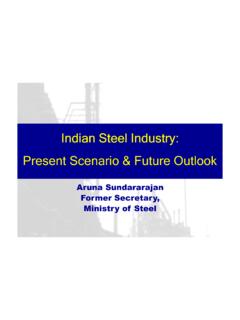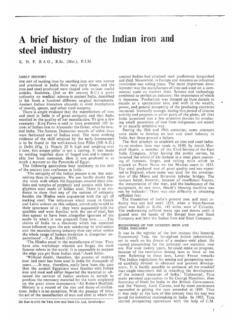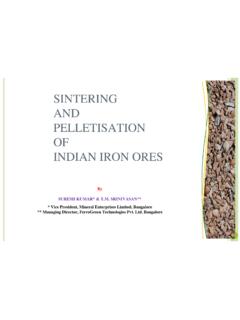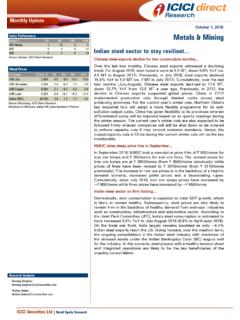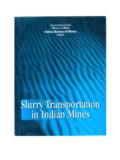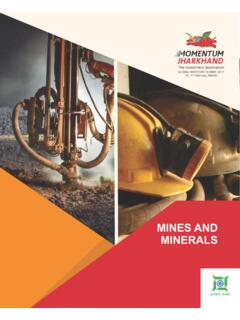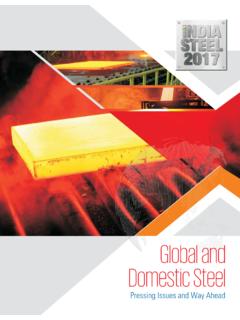Transcription of Indian Iron Ore Scenario : Low Grade Iron Ore Beneficiation
1 Indian iron Ore Scenario : Low Grade iron Ore Beneficiation Anand Kumar, Manager (mining), Omendra Singh, Design Engineer (Mining) MECON Limited, Ranchi - 834 002 Email : Abstract Wide reserves of iron ore is found in India which is the basic raw material for iron and steel industry. Draft National Steel Policy 2012 of India envisages the ambitious goal of the nation to reach a production capacity of 300 Mt/yr of crude quality steel by 2025 - 26. So the corresponding demand of iron ore containing 62 - 64 % Fe would be around 490 Mt (excluding our export requirement). To cope up with increasing global and domestic market demand and to achieve the goals of National Steel Policy, our steel industry is in need of large quantity of iron ore. Due to the high quality of iron ore available in India, large deposits of Banded Haematite Jasper (BHJ) are left unused because of the presence of silica in unwanted quantity.
2 ROM is put through washing to remove the clayey matter due to the presence of alumina and silica in iron ore leading to slime generation which are disposed off in tailing ponds. Slime in these tailing ponds contains iron values in the range of 45 - 60 %. Appropriate Beneficiation process has to be explored to reduce the waste generation in mines and for the sustainable growth of the iron ore industry. In addition to this, depletion of high Grade iron ore, stringent environmental regulations involved in opening of new mines, problems involved in handling, disposal of tailings (slimes), and utilizing of iron ore at 45% Fe as a cut-off fixed by Indian Bureau of Mines, it is the need of hour to effectively beneficiate low Grade iron ore. Apart from the reserves of low Grade iron ore, the previous washing methodology adopted in mining industries which had discarded the slimes as well as fines containing Fe value between 45%-55% have added 10-15 Mt every year and have been dumped somewhere as a big heap or in tailing pond.
3 It is required to utilize these lost minerals in main stream by making sinter/ pellet using advance techniques of Beneficiation involving gravity, magnetic and floatation process, etc. This paper briefly outlines the necessity and the relevance of Beneficiation processes in low Grade iron ores to make them suitable for Pelletization in a techno economical and environmental friendly manner. Introduction India is bestowed with large and rich sources of iron ore in terms of quantity and quality with respect to world Scenario . India occupies sixth position in iron ore resource base and ranks fourth with respect to world iron ore production. The existing reserves of hematite (averaging around 63 % Fe) are the only source of iron ore and as such, these reserves may not last beyond 25 30 years at the present rate of consumption.
4 Hence to meet the future and projected requirement, additional domestic resources like slimes and fines dumped elsewhere in mines have to be utilised, which are in abundance. The ores and minerals are site specific, non-renewable and finite. It is a challenging task for iron ore producers to meet the demand as envisaged in the draft national steel policy. In order to meet the demand, the iron ore producers has to face challenges like increasing the resource base, increasing production and productivity, utilisation of low Grade iron ores, Beneficiation of low Grade fines and slimes, overcoming the infrastructure bottlenecks like roads, railways, ports, power, capital and water, human resource, handling, storage and utilisation of slimes/tails, encouragement for R&D activities, adopting environmental friendly measures and land acquisition for setting up new plants.
5 In this paper, broadly all the above aspects have been discussed. Most of the washing plants located in mines generate lumps as well as fines. During this process, a large quantity of slimes is generated containing around 48%-60% Fe content which is discarded as tailings. According to the latest guidelines issued by IBM, the cut off Grade for tailings is 45%. This huge accumulation of slimes poses environmental problems particularly during rainy season when these fines get washed away and affect the agricultural fields and water bodies. Due to increased demand and continuous depletion of high Grade iron ore, it has become necessary to develop technology to effectively beneficiate low Grade iron ore. iron Ore Resource in India In India, the total resources of iron ore are estimates as Billion Tonne and the distribution between hematite and magnetite have been estimated as Billion Tonne and Billion Tonne, respectively.
6 However, inspite of available magnetite ore, the same have not been exploited due to its occurrence in eco-fragile / sensitive area and due to restrictions imposed by Hon ble Supreme Court. Accordingly, hematite ore will continue to be a primary source to iron & steel industry of the country. In India, hematite ore has been categorised in following grades. Grade % Fe (SiO2+Al2O3)% High- Grade > 65% Fe 2% to 4% Medium- Grade 62 - 65% Fe 6% to 8% Low- Grade < 62% Fe 10% to 15% Slime / Fines Dump Indian haematite ores are generally rich in iron content but usually have high Alumina. The current mining methods generate a lot of fines, almost to the tune of 60%. Over the years these fines got accumulated causing significant environmental impact. Also the slimes generated during Beneficiation contain an iron value of 40-55%, which are being discarded till now and is dumped in mines heads.
7 Significant quantity of slimes, about 18 - 25 % of ROM has been generated during wet processing of the high Grade iron ore. The amount of iron ore being lost in the tails is of the order of 10 - 15 Million tonnes per year. These slimes have been dumped in the tailing ponds in the mine area and are posing environmental hazards. These slimes are readily available in finer size typically assaying 55-60% Fe and 6-8% alumina eliminating the need for crushing to finer sizes. Draft National Steel Policy (NSP) The draft National Steel Policy 2012 aims at transforming Indian steel industry into a global leader in terms of production, consumption, quality and techno-economic efficiency while achieving economic, environmental and social sustainability at par with the developed world. The major objective of draft NSP is to attract investments in Indian steel sector from both domestic and foreign sources and facilitate speedy implementation of investment intentions on board so as to reach crude steel capacity level of 300 Million tonnes by 2025-26 to meet the domestic demand fully.
8 iron ore requirement to meet the objective of draft NSP Quality / Size Requirement of iron Ore in Steel Industries The quality requirement of iron ore concentrate for steel production in India is mainly governed by silica and alumina. Apart from silica and alumina other minor deleterious impurities such as sulphur, phosphorous, arsenic, zinc, lead and other metals are to be also considered. The Al2O3 / SiO2 ratio should be less than one for blast furnace feed. The quality specification of ore for iron making industry is summarized below: BF Lump Sinter Fines Pellet Fines Sponge iron Feed Size Range (mm) -30+10/8 -10/8+ -18/16+5 Fe % Silica % (Max.) 2 2 Alumina% (Max.) 2 2 Necessity of Beneficiation Process There are numerous reasons why it is beneficial to introduce washing of raw iron ore resources to increase efficiencies in steel production and maximize revenues from the material.
9 The presences of contaminants such as alumina and silica have a negative effect on the steel production process as they are a direct cause of high production costs. By reducing the presence of these contaminants in the feed material, the processing of the iron ore becomes viable as a result of the cost reduction. These are outlined in detail here with specific reference to experience in the Indian market. If the Fe value of the ore feed is much less than 62%, productivity of Blast furnace will be less because of use of more quantity of ore and high slag volume. Another unwanted contaminant within raw iron ore is Silica. Therefore, the more silica that exists in the raw material more will be flux addition in the furnace resulting in higher slag volume and lower productivity. Due to presence of high alumina, the blast furnace productivity is significantly affected.
10 High alumina slag which is highly viscous requires larger quantity of flux addition (8 - 12 % MgO) to make it fluid. The relatively larger slag volumes will result in an increase in coke consumption. It is estimated that a decrease in alumina content in the sinter from to will improve the RDI by at least six points, lower blast furnace coke rate by 14 kg per tonne of hot metal and increase its productivity by about 30 % under Indian operating conditions. This process offers significant advantages not only for steel producers, but also for those involved in the trading of iron ore on the world market as the commercial value of the ore is substantially increased as a result of increase in Fe value. Low Grade iron Ore Beneficiation In the past 50 years, due to high demand and intensive mining operations, the high Grade deposits are depleting fast.

